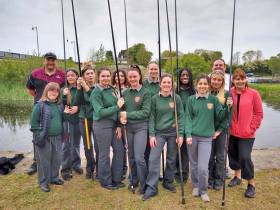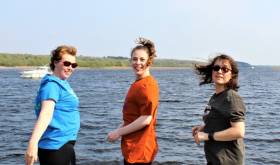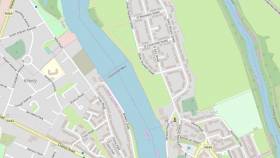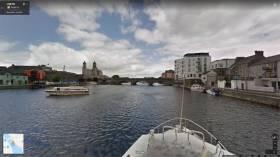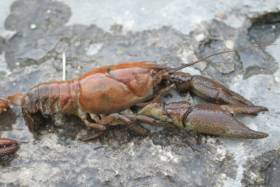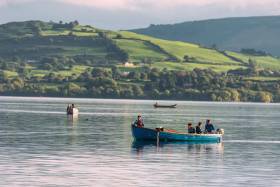Displaying items by tag: River Shannon
Oil Spill On River Shannon Near Athlone Kills Fish and Birds
The Irish Times says Westmeath County Council is investigating an oil spill on the River Shannon south of Athlone in which a number of fish and birds have died.
Efforts were made to contain the spill on the Al River, a tributary of the Shannon, after it was discovered at the weekend. The incident also affected marine wildlife in an area town as the Big Meadow some 1km from the Shannon bridge in Athlone.
Wildlife charity volunteers worked to rescue a number of cormorants and cygnets from the polluted waters, many of which needed special cleaning to remove oil from their feathers, while fish were also recovered for safety with the help of local anglers.
The Irish Times has more on the story HERE.
Waterways Ireland has issued Marine Notices related to a number of events taking place on Ireland’s inland waterways this weekend.
On the Royal Canal, a Junior Canoe Polo Competition will take place at Kilcock Harbour from 10am to 6pm tomorrow, Saturday 22 June.
Passage will be possible between 1pm and 2pm. Masters of other craft are requested to proceed at slow speed and with minimum wash and note any directions issued by the stewards.
On the Shannon-Erne Waterway, masters and owners of vessels are advised that they may experience short-term delays between Lock 1 at Corraquill and Ballyconnell Marina between 1pm and 6.30pm tomorrow due to the waterway’s 25th anniversary event.
Masters are requested to proceed at slow speed and heed any instructions issued by the event marshals.
Elsewhere on the River Shannon, the swimming element of a triathlon event will take place in Tarmonbarry on Sunday 23 June between 9.30am and noon.
Tarmonbarry lock will be closed to traffic during this time, and the N5 Shannon lifting bridge will also be closed, requiring large airdraft vessels to berth north of the bridge for the period.
A children’s swimming event will take place at 6pm on Saturday in Tarmonbarry, but this will not affect vessels in the navigation.
Masters are requested to proceed at slow speed and with minimum wash when approaching this section of the river and heed any instructions issued by the event marshals.
Meanwhile, on Upper Lough Erne, masters and owners of vessels are advised that dredging works are due to commence at Kilmore Quay on Monday 1 July and last for approximately nine weeks.
The map below shows the area to be dredged and the route the vessels will be taking in order to bottom-dump the material.
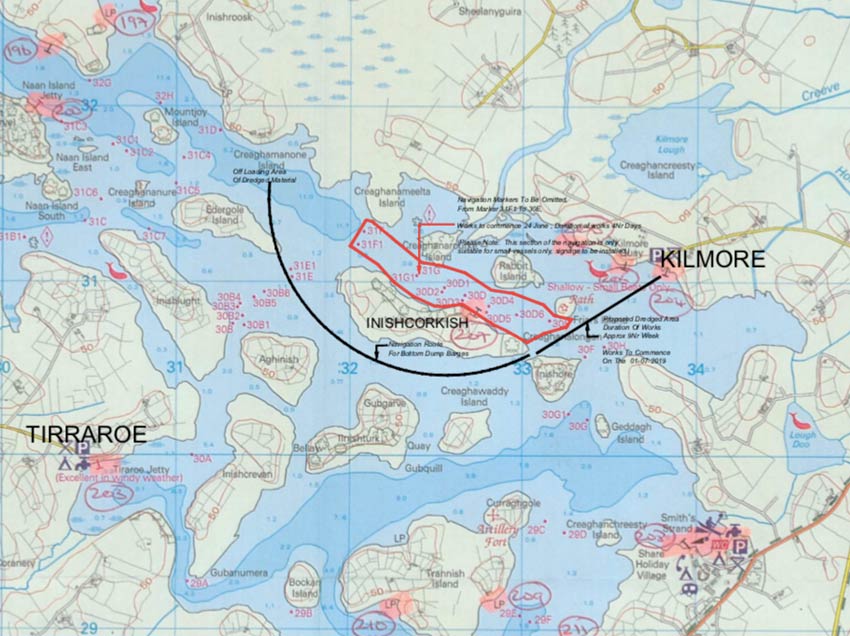
Masters of vessel are requested to proceed with additional caution in the vicinity of the dredging operations and dredging vessels.
Waterways Ireland thanks its customers for their co-operation in this and all other matters.
Shannon Angling Hub Warns Of Threats To Its Future
Chronic lack of maintenance of the Lanesboro Angling Hub on the River Shannon at Lougg Ree is putting the amenity at risk, as the Longford Leader reports.
Hub secretary Philip Gordon warned that “several serious issues” are affecting the area’s renowned ‘hot water’ stretch downstream of the ESB plant, including unchecked weed growth, invasive asian clams, nighttime poaching and reduced water levels.
“Year on year the water is getting more shallow, which is less friendly for fish habitats,” he said. “If there is no habitat for the fish, they just won’t come in and then this place is lost as a fishery, which is a crying shame. Once it’s gone it’s gone.”
However, there is some hope for the future, with recent Transition Year outings introducing local young people to the benefits of angling as a “great stress buster”.
The Longford Leader has more on the story HERE.
A trio of self-described ‘ordinary’ women will be attempting the extraordinary later this summer when they set out to swim the length of the River Shannon for charity.
Fló Beo, which means ‘the living flow’, developed from an idea that 20-year-old Heather Maxwell discussed over tea with her mother Eileen. Soon enough they recruited Toni McGlynn, a fellow member of Lough Key Triathlon Club, to their cause.
The team comes with a solid background in open water swims including Swim Lough Rynn, the Metal Man Series, Glencar Lough Swim and Lough Mask.
But the Shannon poses a different challenge all together, and only two others have swum its full 245km length — American Dan Hall in 2018 and Patrick McDonnell last year.
If Heather, Eileen and Toni complete their challenge, they would be the first ever women to swim the length of the Shannon.
“The prospect of swimming the distance is a great challenge for us, but one we are totally relishing,” say the trio, who will be swimming from Dowra in Cavan to Arthur’s Quay in Limerick in the month of August to raise funds for mental health awareness charity A Lust for Life as well as the Irish Cancer Society.
However, the team can’t achieve their goals without support, and they are currently appealing for someone who could lend them or sponsor the hire of two support boats to accompany them on their journey for rest stops and overnight accommodation — better yet if the owners are willing to join their adventure as skippers.
For more details and to follow their journey, see the Fló Beo Facebook page as well as the trio’s GoFundMe page and additional sponsorship levels.
Girl In Hospital After Boat Overturns In Limerick City
RTÉ News reports that a 12-year-old girl was hospitalised after an incident on the River Shannon in Limerick city yesterday morning (Saturday 23 February).
It’s understood that she was one of four girls on a boat that overturned in the river near the Old Salmon Weir.
The casualty became trapped underneath as her hair tangled with the boat’s outriggers, according to BreakingNews.ie.
An eyewitness said the girls’ rowing boat was in a fast current and had broken in two.
“I’m haunted all day. It’s the screams. I can still hear the girls screaming, ‘help, help help’,” said local man Danny Ryan, who rang 999 as he watched the scene unfold.
The casualty was freed from the boat by a team of firefighters trained in river rescue who were alerted while on patrol at the time.
Elsewhere, the Irish Coast Guard were involved in a ‘difficult’ rescue of two people from Poll na Péist on Inis Mór in the Aran Islands, which previously hosted the Red Bull Cliff Diving World Series.
Explore The River Shannon Virtually Via Google Maps
Planning an inland waterways cruise this spring or summer? Or simply curious to explore the wonders of Ireland’s longest river from anywhere in the world?
Now you can visit the River Shannon virtually thanks to the new boaters-eye view on Google Maps.
As previously reported on Afloat.ie, ‘river view’ images from this past summer’s Google Trekker survey of the River Shannon went live on Google Maps in December.
In conjunction with Waterways Ireland, the Google Trekker Loan Programme toured from Lough Allen to Loop Head gathering data for what amounts to “the first such water-based collection of imagery on the island of Ireland”.
Waterways Ireland pitches the project as “an invaluable tool in terms of promoting the Shannon Navigation as a destination for recreation, tourism, mindfulness, education and heritage appreciation, encouraging visitors to the area”.
But it will also be of use to communities along the waterway “to highlight this heritage asset and foster as sense of place”.
The Google Trekker footage of the Shannon River is now live on Google Maps and can be viewed via the ‘Street View’ function.
Water Users Called On To Help Limit Crayfish Plague Outbreak In Athlone
All water users along the River Shannon are being urged to take precautions after confirmation of an outbreak of crayfishrayfish plague on a stretch of the Al River.
This river is one of the main tributaries to the River Shannon in Athlone and flows westerly, entering the Shannon downstream of the weir.
A small number of dead freshwater crayfish were reported on the river last week. DNA analysis by the Marine Institute has now confirmed that crayfish were infected with the fungus-like organism responsible for causing crayfish plague.
Further analysis is still ongoing to establish if there may be any links between this and previous outbreaks of crayfish plague.
Crayfish plague only impacts native white-clawed crayfish. Fish and other freshwater animals are not affected.
The disease infects species of crayfish and experience elsewhere indicates the disease can cause up to 100% mortality in white-clawed crayfish species.
Agencies including the National Parks and Wildlife Service, Westmeath Municipal and County Councils will be working together to erect signage along the Al River and information will be on the Westmeath County Council website.
Crayfish plague is recognised as a very significant threat to the survival of the globally threatened white-clawed crayfish in Ireland.
The disease is considered fatal to all infected native crayfish and the experience in other countries is that where outbreaks occur there is complete extermination of white-clawed crayfish populations. It is spread invisibly in water and the infectious stage may be moved to other river and lake systems on equipment, boats and machinery.
The crayfish plague comes from the North American species of crayfish, which are now widespread in the UK and on the continent of Europe. To date there are no known records of these American species in Ireland and it is against the law to bring them into Ireland, to sell them, distribute them or release them.
This is the seventh confirmed outbreak of the disease in the whole of Ireland since it was first found in 2015 in Co Cavan, followed by four separate confirmed outbreaks in 2017 and one confirmed outbreak in Northern Ireland earlier this year.
The closest known previous outbreak to this was one in the Lorrha in Co Tipperary and it is not known how the disease could have spread to the River Al at this time.
Anyone involved in activities in the Al River and River Shannon should observe the ‘Check, Clean and Dry’ protocol once they leave the river and before visiting any waterway again. This includes community and local authority clean-up groups, survey work, as well as anglers and all recreational water uses.
All wet gear (boats, clothing and equipment) should be checked for any silt or mud, plant material or animals before being thoroughly cleaned and finally dried.
Disinfectant or hot water (over 40 degrees Celsius) should be used to clean all equipment and this should be followed by a minimum 48-hour drying period (preferably longer, up to a week).
Members of the public will see any dead or dying crayfish should report this to National Parks and Wildlife Service, Westmeath County Council, or Colette O’Flynn at the National Biodiversity Data Centre, Waterford at [email protected].
Anyone who suspects they have seen a non-native species of crayfish are asked to take a picture of it showing the underside of the claws and submit via the National Biodiversity Data Centre’s invasive species record form or direct to Colette O’Flynn.
Have A Taste At The Athlone Shannon Feastival This Weekend
The Athlone Shannon Feastival this weekend 8-9 September expects to attract thousands of people to the Midlands town to take part in and enjoy the action packed lineup of activities on and off the Shannon and Lough Ree waterways.
This year's Feastival is the opening act to the World Canals Conference from 10 September, expected to attract over 400 delegates from all over the world to Athlone.
The Radisson Blu Festival Marquee, located at the walls of Athlone Castle, will be the hub for the festival, hosting workshops, talks, demos and kids’ entertainment.
The Feastival’s official launch event takes place on Saturday afternoon at 4pm when the Sheraton chefs will be busy shucking oysters to accompany Guinness from Sean’s Bar and jazz at the Feastival HQ.
Vikings are landing and will set up the Sheraton Viking Settlement at The Strand, where visitors can experience Viking life by exploring the medieval village and seeing weapon making, embroidery, medieval cooking and more.
On Saturday evening, local chefs sharpen their knives and wield their tongs for the Viking BBQ Cook-Off at 6pm, an event sure to satisfy the appetite.
On Sunday, why not treat yourself by visiting the Sirana Spa Wellness Area for some pampering? Or for a bit more action, watch the local crews as they battle it out to be crowned ‘Champions of The Shannon’ in the leisure boat rowing races.
Professional flyboarders take centre stage at 4pm as they hover over the river performing a variety of amazing stunts and tricks.
The Flogas Demo Kitchen hosts a series of foodie talks, cooking demos and tasty treats all afternoon. And at 6pm Viking Mike casts off and sets sail for a Viking whiskey cruise hosted by Midlands Whiskey Experiences.
Cafés and restaurants participating in the Feastival Food Trail all weekend include The Fatted Calf, Kin Khao, Thyme, Smoke BBQ, The Corner House Bistro, Fine Wine & Food Company, La Cucina Di Angelo, Radisson Blu Hotel, Hodson Bay Hotel, Sheraton Athlone Hotel and The Prince Bar, with more to be announced.
Fashion puts its best foot forwards at The Feastival Fashion Trail. Burgess department store hosts a series of workshops from 11:30am on Saturday with Kathryn Byrne of Your Image Matters, and Athlone Town Centre hosts a ‘Style Squad’ event with stylist Rebecca Rose and Tanya from the My Little Love Stories blog from noon to 4pm.
Meander the Music Trail around Athlone’s pubs featuring sessions at Sean’s Bar, The Snug, The Castle Inn, Fiddler’s Bar, The Malt House, Sheraton Athlone Hotel Bar, the Quayside Bar at the Radisson Blu Hotel, The Prince Bar, and the Waterfront Bar in the Hodson Bay Hotel.
The Artisan Food Village, open Saturday and Sunday, will showcase the best of locally produced food from producers including Kilbeggan Chocolate, Tara Jams, Wild Irish Foragers, KO Kombucha, Quarrymount Farm, Durrow Mills, Behan’s Fruit & Veg, Harvest Café, Radisson Blu Hotel, Prince of Wales Hotel and more.
Other highlights of the weekend include:
- Heritage boat spectacle and cruiser flotilla.
- Whiskey walking tours and tastings with Athlone Whiskey Tours.
- Performances by The Band of the 2nd Brigade and recitals of ‘Poetry in the Park’ at Athlone Castle.
- Free guided tours at selected times at Athlone Castle and Luan Gallery.
- ‘Reflections’, a special Waterways Ireland archive exhibition at Abbey Road Artist Studio and Luan Gallery.
“There’s a palpable air of enthusiasm around in advance of the Feastival,” said Athlone Chamber’s John McGrath. “And it’s great to see local businesses jumping on board and supporting the event in so many ways."
World Canals Conference Looks To China For Inspiration
#WCC - Zhu Minyang completes the list of keynote speakers at the upcoming World Canals Conference in Athlone next month.
Zhu has been the chair of the World Historical and Cultural Canal Cities Cooperation Organization (WCCO) since 2012, and has also served as party secretary of the city of Jiangyin and as mayor of Yangzhou, the ‘first city of the Grand Canal’.
Zhu personally participated in the selection of China’s Beijing–Hangzhou Grand Canal for the World Heritage List in 2014. He has extensive insights and experience in the development of Chinese social organisations and contemporary social governance.
Through his leadership, the WCCO has become a platform for economic and cultural exchanges focused on the world’s canal cities.
Zhu will address the conference on how the WCCO is supporting the renovation of China’s most famous canal. Through economic and ecological restoration and investment in heritage and cultural research, it is intended that a “human community with shared destiny” will develop to create deeper co-operation and regeneration opportunities for China’s canals.
Zhu Minyang will address the conference under its first theme, ‘Restore’, which calls for reflection on how 200-year-old man-made navigations remain relevant for people today.
Over the course of the conference, a variety of speakers from across Europe, Canada and the US will detail restoration works along their waterways as well as how they ensure that no heritage value is lost in these restorations.
John McKeown will speak on restoring the Royal Canal, Roger Squires will cover new approaches to restoration, while Pam Veinotte discusses evolving heritage assets to meet modern-day needs.
Restoration of the Shannon–Erne Waterway is the subject of Joseph Gillespie’s talk, while
Rudy Van der Ween talks the re-opening of the Lower Scheldt in the city centre of Ghent in Belgium, and Rob Vrojliks puts the focus on Limburg in the Netherlands and its regional masterplan approach.
From the US, William Holdsworth will explain how the Chesapeake & Ohio Canal Aqueduct restoration at Williamsport, Maryland brings history alive, while Theron Robson talks maintenance of heritage lock gates on the River Shannon, and Roger Alsater assays preservation efforts for the Göta Canal in Sweden.
‘Regenerate’ (focused on water management challenges) and ‘Reimagine’ (on engaging a wider audience with their local waterways) are the other two tracks at the World Canals Conference which begins in 37 days’ time. Details can be found on the World Canals Conference website.
President Michael D Higgins To Speak At World Canals Conference In Athlone This September
#InlandWaters - President of Ireland Michael D Higgins has been confirmed as a guest of honour at the World Canals Conference in Athlone this autumn.
“We are honoured that the President who throughout his career has demonstrated his commitment to and love of the inland waterways of Ireland, their history and culture, has agreed to speak at the conference and we look forward to hearing how he perceives the restoration, regeneration and reimagining of the waterways,” organisers said.
There are 53 days and counting till the three-day conference from 10-12 September at the Radisson Blu Hotel Athlone under the theme ‘restoring, regenerating, re-imagining’ — with various tours and sessions designed to inspire and connect delegates coming to the Midlands from all around the world.
These tours include an excursion around Lough Derg, the largest and most southerly lake on the River Shannon, that takes in the 1700s bridge linking Killable and Ballina as well as the Ardnacrusha hydroelectric plant, and will explore the challenges of doubling moorings along an old navigation.
Another technical tour will explore the North Shannon, Lough Allen Canal and the Shannon-Erne Waterway, with a stop at the Acres Lake floating boardwalk and a look at the marriage of modern and traditional locks at Kilclare.
As previously reported on Afloat.ie, the conference will be preceded by the three-day Shannon Athlone Feastival, highlighting local food producers in an exciting festival atmosphere with rowing, raft racing, a Viking village and demonstrations of flyboarding that wowed the crowds at the recent SeaFest in Galway.
Special rates for accommodation on board luxury cruise liners are still available, as are a range of exhibition opportunities for organisations looking to network with delegates. Details can be found on the World Canals Conference website.





























